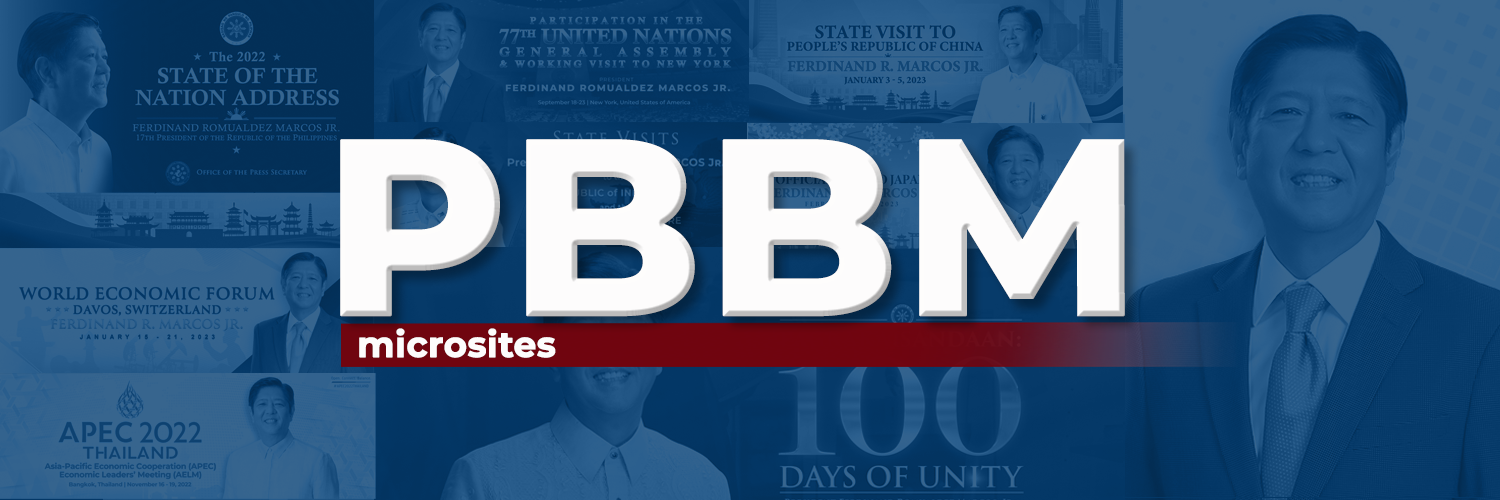March 11, 2016 – News Releases
 |
| 11 Mar 2016 |
|
|
|
| President Aquino asks Caviteños to continue supporting “Daang Matuwid” agenda |
| (DASMARINAS CITY) Caviteños could reap the full benefits of the “Daang Matuwid” reform agenda if they elect administration candidates in this year’s election, President Aquino said on Thursday.
In a speech during a meeting with the local community in Cavite, the President said electing the administration’s presidential bet, Mar Roxas, could ensure the continuity of the projects carried out by the government in the province. Among these projects completed, the administration in Cavite include the Muntinlupa-Cavite Expressway or MCX, which was inaugurated by the government last year. The MCX Public-Private Partnership project was spearheaded by the Aquino government. Also last year, the government opened the 44.63 kilometer Cavite-Laguna Expressway or CALAX, another PPP project of the administration. The government also approved the construction of the LRT Line 1 South Extension Project, from Baclaran to Bacoor, Cavite as well as the LRT Line 6 Project, that will start from Bacoor to Dasmariñas City. The project will benefit those working in Manila but residing in Cavite, the President said. Also, the government will soon start the Southwest Integrated Transport System Project that will permanently replace the Southwest Interim Provincial Terminal. “Oras na matapos ang naglalakihang proyektong ito, isipin niyo ang pangmatagalang benepisyong matatamasa ng mga Caviteño,” he said. The government’s road, bridge and irrigation projects are also aimed at helping the province’s agriculture sector. The President reported that in Cavite, the administration constructed 49 farm-to-market roads and 59 irrigation projects. It also provided 22 Shared Service Facilities that will benefit those engaged in coffee processing, he said. “Sa kabuuan, pag sinuma ninyo ang lahat ng pondong inilaan natin sa DPWH para sa pagpapagawa ng mga kalsada, tulay, at iba pang imprastruktura sa Cavite, mula taong 2011 hanggang 2016, aabot po yan sa P20.53 billion,” President Aquino said. “Malamang hindi po niyo alam ‘to. Halos apat na beses ang laki nito sa P4.8 billion na inilaan sa inyong probinsya ng ating sinundan, mula 2005 hanggang 2010.” For health services, the President said there are 2.76 million Caviteños enjoying PhilHealth coverage. They are part of the 93 million Filipinos being supported by PhilHealth throughout the country, he said. Daang Matuwid is also generating jobs in Cavite through TESDA, President Aquino said. There are around 30,000 Training for Work Scholarship Program (TWSP) graduates in Cavite from 2010 to 2015, he noted. “Bahagi lang po sila ng 9 million graduates ng TESDA sa iba’t ibang kurso sa bansa. Kaya naman po sikat na sikat si Tesdaman (Joel Villanueva),” he said. “Ang maganda po sa suportang binibigay natin sa scholars ng TESDA, unang taon pa lang sa empleyo, sa tax pa lang, bawi na at may dagdag pang kita pa ang Estado para mabigyan ang iba ng parehong opurtunidad.” The government’s Pantawid Pamilyang Pilipino Program is also helping more than 50,800 households in Cavite according to the President. Throughout the country, there were 4.6 million households being supported under the program. Because of the program, there are 7.7 million Filipinos lifted out of poverty based on latest assessment, he stressed. Prior to his event in Dasmariñas City, the President attended the 37th commencement exercises of the Philippine National Police Academy in Silang, Cavite, Thursday morning. PND (as) |
|
|
| Climate Change Commission goes to grassroots for stronger, deeper cooperation with communities at risk |
| The Climate Change Commission (CCC) has rolled out on Thursday a revitalized partnership with grassroots communities within the 18 major river basins of the country in a bid to promote a risk-and-science-based approach to climate change adaptation and mitigation planning among local government units (LGUs).
Dubbed as Communities for Resilience (CORE), the CCC intends to promote the understanding of climate and disaster risk especially by communities identified by experts to be more vulnerable to disasters caused by climate change, and strengthen the technical knowledge and capacity of LGUs in developing the Local Climate Change Action Plan (LCCAP) through a series of convergence consultations and trainings. Through CORE, the CCC also aims to help facilitate access of grassroots communities, LGUs, and people’s organizations to the People Survival Fund (PSF) in order to support their respective climate change adaptation and mitigation programs. CORE is an improved “ECOTOWN program” launched in August 2011, and an important component of the National Convergence Program on Managing Climate and Disaster Risks for a More Resilient and Sustainable Philippines. Secretary Emmanuel de Guzman, vice chairperson of the CCC which is chaired by President Benigno S. Aquino III, led the first CORE Convergence Forum in Davao City from March 10-11. The pilot CORE Convergence Forum involves stakeholders from 18 LGUs located around the Tagum-Libuganon River Basin. “Combining all the important aspects of the climate change adaptation and mitigation (CCAM) projects and the disaster risk reduction and management (DRRM) programs of the present government will lead to a more coherent, holistic, substantial and meaningful approach and strategies to significantly lessen the risks linked to climate change and to the geophysical hazards many communities are exposed to daily,” De Guzman said. The CCAM and the DRRM are two distinct strategies, but both of them aim to substantially reduce risk and vulnerabilities directly and indirectly caused by national disasters, De Guzman also explained, noting the provisions of the Climate Change Act of 2009 and the Philippine National Disaster Risk and Management Act of 2010. The annual natural calamities and hazards which affect the Philippines is costing the country 5 percent of the yearly gross domestic product, according to the World Bank. Losses and damages from Super Typhoon Yolanda alone were placed at $15 billion or roughly P650 billion. De Guzman added that the socio-economic losses due to natural calamities and hazards is likewise accompanied by loss of lives and injuries to thousands of Filipinos as more and more Filipinos are occupying or settling down along coastlines, waterways and landslide-susceptible and -prone areas. “It may be sad or inappropriate to say. But the Philippines has become one of the best poster boys for climate change vulnerabilities. We need to act decisively and collectively now,” De Guzman said. “Failure to appropriately prepare for and implement the much needed programs and projects on the combined climate change adaptation and mitigation projects and the disaster risk reduction and management programs may lead to more devastating disasters in the country. Simply, we cannot afford to lose more lives and incur bigger socio-economic losses,” he also said. The CORE Convergence Forum will be conducted throughout the year to cover other major river basins across the country such as the Pasig-Laguna, Pampanga, Agno, Abra, Cagayan, Agusan, Mindanao, Ilog-Hilabangan, Tagoloan, Cagayan De Oro, Ranao (Agus), Davao, Buayan-Malungon, Bicol, Panay, Jalaur, and Apayao-Abulug. The 18 Major River Basins are identified as key priority areas by the Cabinet Cluster for Adaptation and Mitigation. PND (ko) |
|
|
| Palace welcomes results of latest Labor Force Survey showing drop in unemployment |
| Malacañang on Friday welcomed the results of the latest round of the Labor Force Survey, which showed that the unemployment rate decreased to 5.8 percent last January from 6.6 percent in the same month last year.“This is the lowest rate recorded for all such surveys conducted in January over the past ten years,” Presidential Spokesperson Edwin Lacierda said in a statement.
The Philippine Statistics Authority (PSA) on Friday cited that the decline in unemployment is relatively broad-based across geography, age groups, gender, and education, according to Secretary Lacierda. The PSA also noted that youth unemployment went down to 14.4 percent in January from 14.9 percent in January last year. The survey further showed that compared to January 2015, total employment two months ago went up by 2 percent to 39.2 million, with an estimated 752,000 additional workers. The services sector, which grew by 5.6 percent percent, remained the top employment contributor, while the industry sector posted an 8.4 percent growth in employment. “The PSA notes that this increase can be attributed to strong employment gains in the construction subsector, partly a result of increased public infrastructure spending during the last quarter of 2015,” Lacierda said. The Palace official also noted that the other indicators of quality employment improved significantly — the figures for wage and salaried employment, full-time employment, and mean hours of work all increased. The number of remunerative and stable wage and salary workers increased by 2.7 million in January, while the share of full-time employment to employment significantly increased to 67.4 percent from 61.6 percent in January last year. “This latest piece of good news points toward our continued upward trajectory along Daang Matuwid,” Lacierda said. “With such positive signs of our vibrant labor market, the Philippines is poised to secure its status as ‘Asia’s Rising Tiger’,” he added. Lacierda said the past five-and-a-half years have allowed the Philippines to take great steps toward progress. “Now, as another crossroads looms before us, it is up to us to decide whether we want to sustain this momentum or again live under uncertainty,” he said. He enjoined the country’s voters to pick the candidates with untarnished integrity and with best track record during the elections in May. “During the coming elections, we trust that voters will discern well among the candidates and choose the one with untarnished integrity and the best track record—the one best suited to lead our country to a brighter tomorrow,” he said. PND (kt) |
|
|
| Climate Change Commission holds consultation to improve climate change roadmap |
| The Climate Change Commission (CCC) on Friday held consultations with representatives of public, private and non-governmental organizations to improve and enrich the draft of the climate change roadmap being finalized by the government.
The CCC has also introduced the “Community-Level GHG Inventory for Local Government Units in the Philippines: User’s Manual” that will guide local leaders and stakeholders in conducting greenhouse gas (GHG) emissions accounting. The manual has been drafted and designed in collaboration with the United States Agency for International Development (USAID) Philippines, through its Building Low Emission Alternatives to Develop Economic Resilience Project. Among those who attended the consultation at the Ateneo University in Davao City were representatives of the city’s small and medium enterprises, the academe, local government units, and development partners. “The objectives of the Davao City consultation were to present the Paris Agreement and to present the draft roadmap and strategies of the Nationally Determined Contributions (NDCs), or the Contributions Déterminés Au Niveau,” said Secretary Emmanuel de Guzman of the CCC. The CCC is a Cabinet-level government agency chaired by President Benigno S. Aquino III. The consultation-workshop likewise crafted strategies to integrate the NDC Roadmap in various national and local development plans, such as the Philippine Development Plan, Philippine Energy Plan, Local Climate Change Action Plan, and Comprehensive Development Plans. “The workshop elicited recommendations to improve the draft NDC Roadmap and to strengthen convergence among local stakeholders for effective and appropriate NDC Roadmap implementation by the stakeholders as they see fit to their local conditions,” de Guzman said. The NDC Roadmap will eventually be the ultimate standards on the Philippines’ enhanced targets to curb carbon emissions and to limit temperature increase. “The NDC Roadmap will hold accountable the Philippine government for its new goals of reaching net zero emissions toward the second half of this century,” de Guzman said. “The Philippine NDC Roadmap is premised on climate change mitigation as related to adaption because of the country’s vulnerability to the impacts of climate change. The NDC Roadmap will be pursued along with the guidelines and goals set by national strategies for sustainable development, low emission development and inclusive growth,” he added. This particular initiative by the CCC uses a “bottom-up approach” to add to the current and ongoing national consultations with all national government agencies. “We want the active and meaningful participation by communities and local government units in this series of consultation-workshops. The adaptation needs and efforts to reduce emissions by the grassroots communities and local government units is the core of the NDC Roadmap,” de Guzman said. The consultation-workshop forum on the NDC Roadmap is one of the avenues in revisiting the so-called “Intended Nationally Determined Contributions (INDC)” submitted by the Philippines to the United Nations Framework Convention on Climate Change in October last year. Under the INDC, the Philippines committed a conditional 70-percent emission reduction rate by 2030, with the decrease in emissions targeted to come from the forestry, energy, industry, waste, and transport sectors. “This convergence is to encourage and engage local communities and private sectors to take on the low carbon development pathway, which refers to, among others, the shift from coal energy to renewable energy, use of farming methods with decreased emissions, green architecture, as well as sustainable and pro-environment business practices,” de Guzman said. He emphasized that the urgency to come up with the roadmap is important amid new international frameworks that have set deadlines for the compliance of member countries, namely the Sendai Framework for Disaster Risk Reduction 2015, Sustainable Development Goals 2015-2030, Addis Ababa Action Agenda 2015, and Paris Climate Change Agreement. PND (ka) |
|
|
| Palace justifies lease of five patrol aircraft from Japan |
| Malacañang has justified the planned lease of five surveillance aircraft from Japan, saying the move is legal and authorized.
China has reportedly expressed alarm over the Philippines’ plan to lease patrol aircraft from Japan to monitor the developments in the South China Sea. “Ayon sa ating Department of National Defense, ito ay isang legal, otorisado, at umiiral na kalakaran o practice ng mga bansang katulad natin na naghahangad na makapag-acquire ng mga kagamitan na gagamitin sa tanggulang pambansa at ito naman ay ginagawa sa legal at maayos na paraan,” Communication Secretary Herminio Coloma, Jr. told reporters during a press briefing at the Palace on Friday. On China’s comments that it is ready to respond to any challenge to its sovereignty, Secretary Coloma said the Philippines, like other countries, wants to ensure freedom of navigation and overflight in the contested waters. Freedom of navigation and overflight are important to ensure unimpeded movement of goods so as not to hamper economic development in the region, he explained. “Walang hangarin ang ating bansa na lumikha ng ligalig diyan dahil ang ating patakaran nga ay ang diplomatiko at tahimik na pagresolba ng mga usapin diyan sa lugar ng South China Sea,” Coloma said. In an event last Wednesday, President Benigno S. Aquino III said the country will lease five aircraft from Japan to help the country’s Navy patrol the Philippine territory in the disputed South China Sea. In addition to leasing the TC-90 training airplanes from Japan, the President said the Philippines will also acquire a dozen military aircraft this year and in 2017 from other countries, including FA-50 fighter jets from South Korea. President Aquino noted that the government has allocated P58.43 billion from July 2010 to February this year to modernize the country’s armed forces. The United States and other allies, among them Japan and South Korea, are the country’s main supplier of military equipment as it strengthens its military amid the territorial dispute in the South China Sea. PND (as) |
|
|
| Existing mechanism enough to fight money laundering, says Malacañang official |
| The Anti-Money Laundering Council (AMLC) is already working to trace those involved in money laundering and hold them accountable, a Palace official has said.
“Sa ating pagkabatid, isinasagawa ng Anti-Money Laundering Council ang lahat ng nararapat na hakbang upang matunton ang mga lumilikha ng ligalig sa ating financial system at umaasa tayo na gagampanan nila ang kanilang tungkulin para mapanagot ang mga responsable para dito,” Communication Secretary Herminio Coloma, Jr. told reporters on Friday. According to news reports, six people are being investigated for the alleged laundering of $81 million stolen by computer hackers from a US account of Bangladesh central bank. Asked if the government is worried about getting a red flag from global financial agencies over this incident, Secretary Coloma said he believes the country has enough mechanisms to prevent money laundering activities. He explained that foreign financial organizations had issued warnings in the past because there was not enough financial infrastructure that would deter illicit transactions. “Sa aking palagay, ang batas nandoon na, nandoon na rin ang Anti-Money Laundering Council, gumagana naman ito,” the Palace official said. “Napatunayan din ito nung nakaraan na kumikilos sa tamang direksyon ang Council na ito para pigilin ang mga illegal na transaksyon, kaya’t umaasa tayo na mapapanatili naman natin ang ating status bilang isang compliant country doon sa aspeto ng international financial transactions.” The Rizal Commercial Banking Corporation (RCBC), which has been dragged into the controversy, has denied tolerating the alleged money laundering activity in its branch in Makati City. The bank has pledged full cooperation with ongoing inquiries of the AMLC and the Bangko Sentral ng Pilipinas. PND (as) |
|
|
| Palace: It is Comelec’s responsibility to ensure orderly conduct of elections |
| It is the responsibility of the Commission on Elections (Comelec) to ensure that everything is in place come election day, a Palace official has said.
“Tungkulin ng Comelec na tiyakin ang pagkakaroon ng tapat at maayos at katanggap-tanggap na resulta ng halalan. At umaasa ang buong sambayanan na gagampanan nila ito. Dahil diyan, dapat lamang ang kanilang mga suppliers at mga contractors ay tutulong sa kanila para matamo ang layuning ito,” Communication Secretary Herminio Coloma, Jr. told reporters in Malacañang on Friday. Secretary Coloma was reacting to reports that Smartmatic needs two months to adjust their machines to comply with the voter’s receipt approved by the Supreme Court. He said that according to the law, election day is set on the second Monday of the month of May and any change of date would require a change in the law. “Ayon sa batas, mayroong nakatakdang petsa para diyan at ito ang ikalawang Lunes ng buwan ng Mayo. Ano mang pagbabago diyan ay kinakailangan ng pagbabago din sa batas at hindi natin nakikita na ‘yan ay isang pangyayari na gustong makita ng marami sa ating mga kababayan,” he said.“At buo ang pag-asa natin na may ilang buwan na at taon na pinaghandaan ito. Ito ay isang national elections, kaya dapat siguro ang direksyon ng ating pananaw ay kung paano mapagtutulungan ng lahat ng sektor ang pagdaraos ng maayos na halalan sa takdang petsa,” he added. PND (jm) |
|
|


















